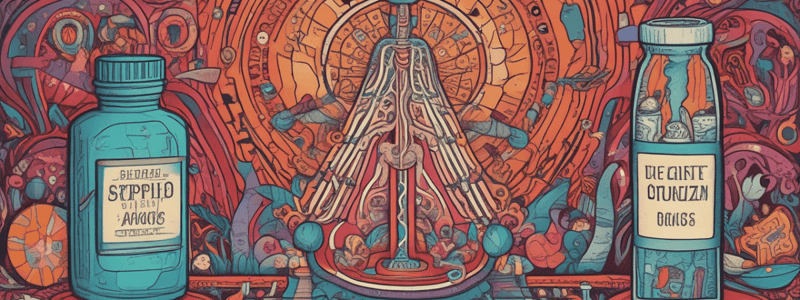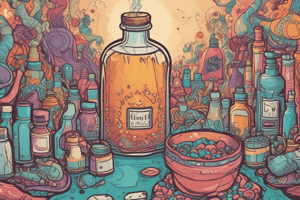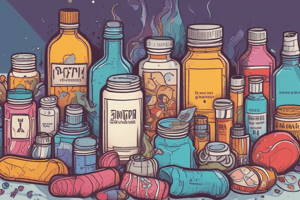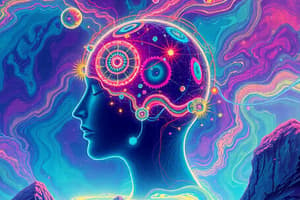Podcast
Questions and Answers
Match the following classes of drugs with their primary effects:
Match the following classes of drugs with their primary effects:
Stimulants = Increase activity of the central nervous system Depressants = Reduce activity of the central nervous system Opioids = Produce euphoria and analgesia Hallucinogens = Alter sensation and perception
Match the following terms related to neurotransmitters with their definitions:
Match the following terms related to neurotransmitters with their definitions:
Neurotransmitters = Chemical messengers in the body Reuptake = Process of neurotransmitter absorption back into the presynaptic neuron Synapse = The gap between neurons where neurotransmitters act Psychological dependence = Desire for a drug without serious physical withdrawal effects
Match the following outcomes of drug use with their descriptions:
Match the following outcomes of drug use with their descriptions:
Tolerance = Increase in the dose required for the same effect Dependence = Need to use a drug regularly Withdrawal = Physical and mental effects when a drug is not obtained Drowsiness = State induced by sleeping pills
Match the following psychoactive drug types with their specific characteristics:
Match the following psychoactive drug types with their specific characteristics:
Match the following forms of dependence with their effects:
Match the following forms of dependence with their effects:
Match the following reasons for using psychoactive drugs with their purposes:
Match the following reasons for using psychoactive drugs with their purposes:
Match the following forms of drug action with their effects on neurotransmitters:
Match the following forms of drug action with their effects on neurotransmitters:
Match the following psychoactive drugs with their broad classifications:
Match the following psychoactive drugs with their broad classifications:
Flashcards are hidden until you start studying
Study Notes
Psychoactive Drugs Overview
- Psychoactive drugs influence consciousness by interacting with neurotransmitters at the synapses in the central nervous system (CNS).
- Neurotransmitters are chemical messengers crucial for communication between nerve cells.
Types of Psychoactive Drugs
- Stimulants: Block reuptake of dopamine, norepinephrine, and serotonin, enhancing their effects. Common examples include caffeine and amphetamines.
- Depressants: Decrease CNS activity, leading to sedation and relaxation. Examples include alcohol and benzodiazepines.
- Opioids: Activate opioid receptor neurons, resulting in euphoria, pain relief, and effects like slower breathing and constipation. Common opioids include morphine and oxycodone.
- Hallucinogens: Alter perception and sensory experiences. Examples include LSD and psilocybin.
Purpose of Psychoactive Drug Use
- Psychoactive drugs can simulate natural states of consciousness, such as relaxation or drowsiness.
- Medications like sleeping pills are prescribed to induce sleep, whereas benzodiazepines aim for relaxation.
- Some users seek psychoactive drugs for pleasurable experiences or to escape reality.
Drug Dependency and Tolerance
- Tolerance: Increased dosage required to achieve the original drug effect, leading to higher consumption.
- Dependence:
- Psychological Dependence: Strong desire for the drug with no serious physical withdrawal symptoms.
- Physical Dependence: Withdrawal symptoms manifest when the drug is not used, including pain, irritability, and cravings.
Withdrawal and Addiction
- Withdrawal describes negative symptoms that occur when reducing or stopping drug use, which may include physical pain and strong cravings.
- Addiction is characterized by a compulsive drive to use the drug despite negative consequences, including physical, social, and legal issues.
Studying That Suits You
Use AI to generate personalized quizzes and flashcards to suit your learning preferences.




